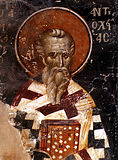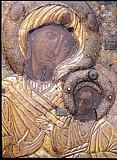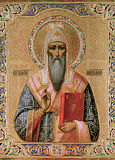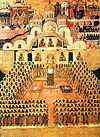

| Previous day | Next day |
| Old Style
February 12
|
Sunday |
New Style
February 25
|
|
First Sunday of Great Lent.
Tone 5.
Great Lent. |
Wine and oil allowed.
|
![]() Appearance of the Iveron Icon of the Most Holy Theotokos (Mt. Athos) (9th c.).
Appearance of the Iveron Icon of the Most Holy Theotokos (Mt. Athos) (9th c.). ![]() St. Meletius, archbishop of Antioch (381).
St. Meletius, archbishop of Antioch (381). ![]() St. Alexis, metropolitan of Moscow (1378). St. Meletius, archbishop of Kharkov (1840).
St. Alexis, metropolitan of Moscow (1378). St. Meletius, archbishop of Kharkov (1840).
St. Mary, nun (who was called Marinus), and her father, St. Eugene, monk, of Alexandria (6th c.) St. Anthony II, patriarch of Constantinople (895). St. Bassian, founder of Ryabovsk Monastery (Uglich) (1509). Hieromartyr Urbanus, pope of Rome (223-230).
St. Ethilwald of Lindisfarne (740). St. Prochorus of Georgia, builder of Holy Cross Monastery near Jerusalem (1066). New Monk-martyrs Luke (Mukhaidze) (1277) and Nicholas (Dvali) (1314), of Jerusalem, and the holy fathers of the Georgian monasteries in Jerusalem. New Martyr Christos the Gardener, of Albania, at Constantinople (1748).
Repose of the cave-dweller Anastasia (Logacheva) of Ardatov (1875).
Thoughts for Each Day of the Year
According to the Daily Church Readings from the Word of God
By St. Theophan the Recluse

The First Sunday of Lent. [Heb. 11:24–26, 32–12:2; John 1:43–51]
The Sunday of Orthodoxy.[1] Do not forget the right word[2] which you spoke to God, renewing your testament with Him which you broke through your negligence. Remember how and why you broke it and try to avoid being unfaithful again. Pretty words are not glorious; faithfulness is glorious. Is it not glorious to have a testament with a king? How much more glorious is it to have a testament with the King of kings! But this glory becomes your disgrace if you are not faithful to this testament. How many great people have been glorified since the beginning of the world! And all of them have been glorified for their faithfulness, in which they stood firm, regardless of great misfortunes and sorrows as a result of this faithfulness. They had trial of cruel mockings and scourgings, yea, moreover of bonds and imprisonment: They were stoned, they were sawn asunder, were tempted, were slain with the sword: they wandered about in sheepskins and goatskins; being destitute, afflicted, tormented; Of whom the world was not worthy: they wandered in deserts, and in mountains, and in dens and caves of the earth…. Wherefore, seeing we are compassed about with so great a cloud of witnesses, let us run with patience the race that is set before us, looking unto Jesus the author and finisher of our faith (Heb. 11:36–38; 12:1–2).
[1] The first Sunday of Great Lent is called “The Sunday of Orthodoxy,” and celebrates the restoration of the veneration of Icons and the victory of Orthodoxy over the Iconoclast heresy.
[2] “The right word” is a reference to the meaning of the word “Orthodox” in Russian, which is literally “rightly glorifying.”
Articles
 Venerable Mary (who was called Marinus), and her father at AlexandriaSaint Mary and her father Eugene lived at the beginning of the sixth century in Bithynia (northwestern Asia Minor). |
 St. Anthony the Patriarch of ConstantinopleSaint Anthony, Patriarch of Constantinople, was a native of Asia, but lived in Constantinople from his youth. |
 St. Bassian of UglichSaint Bassian came to the Protection monastery when he was thirty-three years of age, and was soon tonsured by Saint Paisius. |
 Triumph of Orthodoxy SundayFr. Thaddaeus HardenbrookAfter the exercise of Clean Week, the wisdom of the Church grants us a rest in the joy of Triumph of Orthodoxy Sunday. |


















